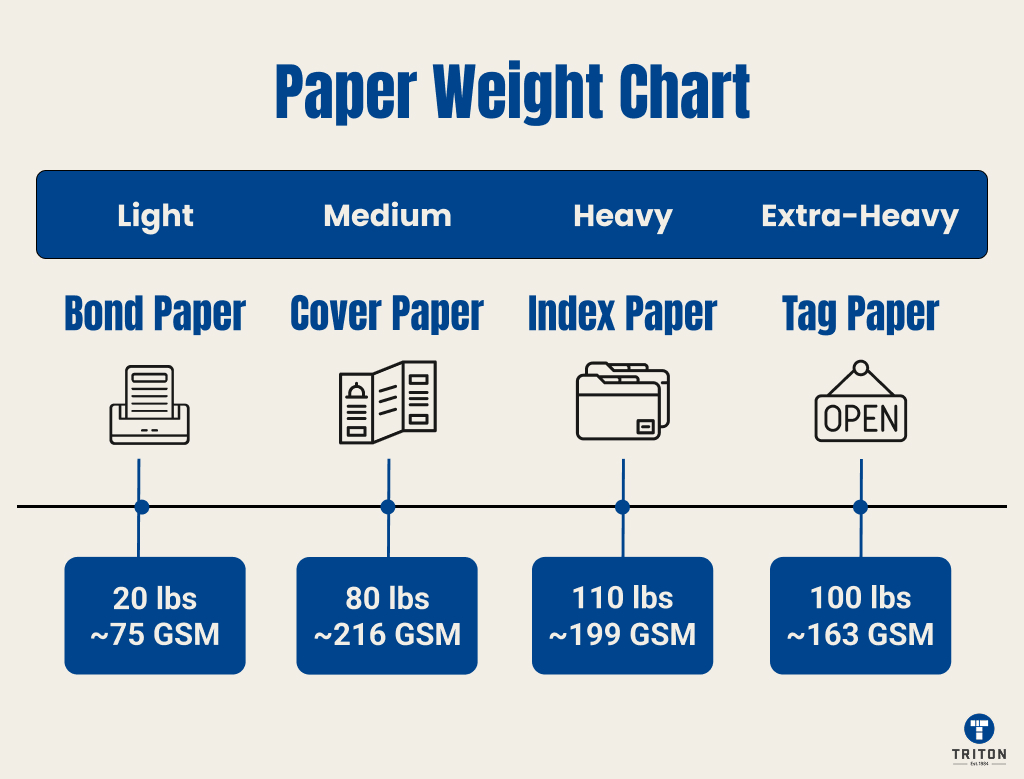
GSM stands for grams per square metre, a measurement used to determine paper thickness and weight. Simply put, the higher the GSM number, the heavier and thicker the paper. This measurement is often called the paper’s grammage. For instance, a 150 GSM flyer feels thin and can easily be folded, whereas a 250 GSM flyer feels considerably thicker and sturdier.
What is GSM?GSM stands for grams per square metre, a measurement used to indicate the weight and thickness of paper. The higher the GSM number, the heavier, thicker, and sturdier the paper. GSM helps you choose the right paper type for printing, packaging, or designing promotional materials. |
Selecting the correct GSM is crucial to avoid costly mistakes, whether printing, packaging, or designing promotional materials.
In this article, we’ll explain the importance of GSM, outline the different types available, and guide you in choosing the best GSM for your needs.

Knowing the various GSM ranges helps you select the ideal paper for printing, drawing, or promotional projects. Here’s a breakdown of the most common GSM categories:
GSM Range | Common Uses | Standard References |
|---|---|---|
35-55 | Newspapers, tracing paper | ISO 536, DIN 19309 |
75-90 | Sketch pads, notebooks, stationery
| ISO 216, ISO 536 |
90-100 | Standard printing paper, basic documents | ISO 216, ISO 9706 |
120-140 | Posters, brochures, flyers | ISO 216, ISO 536 |
210-300 | Magazine covers, promotional flyers, art paper | ISO 216, ISO 9706 |
350-450 | Cardstock, business cards, invitations, packaging | ISO 216, ISO 9706 |
The lightest papers range between 35 and 55 GSM. They are thin, flexible, and nearly transparent. Common uses include tracing paper and newspapers.
Architects and artists often use tracing paper for transferring designs and sketches due to its transparency. Newspapers prefer this GSM because it’s affordable, easy to fold, and suitable for mass distribution, although it’s less durable.
Paper between 75 and 90 GSM is commonly found in sketch pads, notebooks, and stationery. It’s suitable for pencil sketches and everyday note-taking, making it popular with students, artists, and office workers.
However, it’s relatively thin, heavier inks, markers, or paints might cause bleed-through or warping.
Most household printer paper falls within 90 to 100 GSM. This is ideal for standard printing tasks such as letters, documents, and assignments.
A higher GSM paper is recommended for documents that require a more premium look and feel, such as résumés or certificates.
Posters commonly use paper weighing between 120 and 140 GSM, which provides durability. This range is robust enough to be displayed without easily tearing yet light enough to roll up for convenient transport.
This GSM is also popular for brochures and flyers, offering a professional appearance without the higher costs associated with thicker premium papers.
Papers within the 210-300 GSM range are noticeably thicker and sturdier and are used for magazine covers and higher-quality promotional flyers, providing durability while remaining flexible enough for frequent handling.
Watercolour paper also typically falls into this category due to its ability to absorb water without warping.
Artists prefer 210-300 GSM because it is strong and absorbent under various painting techniques.
The heaviest papers, ranging from 350 to 450 GSM, are categorised as cardstock. These papers are thick and sturdy, resembling thin cardboard. Cardstock is often used for business cards, invitations, and greeting cards, giving them a premium, professional feel.
Due to its stiffness and durability, cardstock is excellent for printed items that need frequent handling or must leave a strong impression, such as wedding invitations or luxury packaging.

While GSM is a universal measurement of paper weight used worldwide, you might encounter other terms, especially in North America, such as Bond, Cover, Index, Tag, and Offset. These categories are based on traditional paper usage rather than actual physical weight. Each type has its unique basis weight measured in pounds (lbs), making comparisons challenging.
Type of Paper (US) | Basis Weight (lbs) | Equivalent GSM |
|---|---|---|
Bond Paper | 20 lbs | ~75 GSM |
Cover Paper | 80 lbs | ~216 GSM |
Index Paper | 110 lbs | ~199 GSM |
Tag Paper | 100 lbs | ~163 GSM |
To simplify things:
For international simplicity, GSM remains the easiest and most reliable standard.
While this guide helps clarify the importance of GSM, it’s equally essential to select high-quality equipment and packaging solutions to ensure your products and materials stand out.
At Triton Store, we specialise in thermal labels, thermal printers, packaging material, and machinery for the food packaging industry. Visit our website today to discover reliable solutions designed to enhance your business.
Auckland
Christchurch
Phone 09 579 2057
Live Chat – Widget below
Auckland
Christchurch
Phone 09 579 2057
Live Chat – Widget below